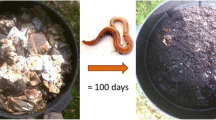Abstract
We investigated the role of earthworms in the N cycle in a shifting agriculture system under a 5- and a 15-year Jhum system fallow period intervening between two croppings on the same site. Earthworms participated in the N cycle through worm cast egestion, mucus production, and dead tissue decomposition. Soil N was initially depleted by volatilization during slash and burn operations, and subsequently during cultivation processes. These losses were more pronounced under the 15-year Jhum system. We also studied the addition of N to the system in crop residues, through weed recycling, or in compost applied as organic manure under both the 5- and the 15-year Jhum systems. The total soil N made available for uptake by the plant through the activity of earthworms in this agro-ecosystem was higher than the total input of N to the soil through the addition of slashed vegetation, inorganic and organic manure, and recycled crop residue and weeds. Therefore, in highly leached soils of the humid tropics, worm activity is particularly, important because of rapid incorporation of litter into the mineral soils and because of local concentrations of nutrients in the surface soil layers.
Similar content being viewed by others
References
Allen SE, Parkinson JP, Quarmby C (1974) Chemical analysis of ecological materials. Blackwell Scientific Publications, Oxford
Bhadauria T (1987) Ecology of earthworms at higher elevations in Meghalaya. PhD thesis, North eastern Hill University, Shillong, Meghalaya
Bhadauria T, Ramakrishnan PS (1989) Earthworm population dynamics and contribution to nutrient cycling during cropping and fallow phases of shifting agriculture (Jhum) in north-east India. J Appl Ecol 26:505–520
Buckman HQ, Brady NC (1960) The nature and properties of soil. Macmillan, New York
Buse A (1990) Influence of earthworms on nitrogen fluxes and plant growth in cores taken from variously managed upland pastures. Soil Biol Biochem 22:775–780
Christensen O (1987) The effects of earthworms on nitrogen cycling in arable soils. In: Stringanov BR (ed) Soil fauna and soil fertility. Proc 9th Int Coll Soil Zool, Moscow, pp 106–118
Jackson ML (1958) Soil chemical analysis. Prentice-Hall, Englewood Cliffs, NJ
Lavelle P (1983) The structure of earthworm communities. In: Satchell JE (ed) Earthworm ecology from Darwin to vermiculture. Chapman and Hall, London pp 449–451
Marinissen JCY, Ruiter de PC (1993) Contribution of earthworms to carbon and nitrogen cycling in agroecosystems. Agric Ecol Environ 47:59–74
Mass JM, Jordan CF, Sarukhan J (1988) Soil erosion and nutrient losses in seasonal tropical agroecosystems under various management techniques. J Appl Ecol 25:595–607
Novak K (1975) Population density of earthworms and some elements of their production in several grasslands environments. Ecol Pol 23:459–491
Ramakrishnan PS (1988) Successional theory: Implication for weed management in shifting agriculture mixed cropping and agroforestry systems. In: Altieri MA, Lubmann M (eds) Weed managements in agroecosystems. Ecological approaches. CRC Press, Boca Raton, Fla, pp. 183–196
Ramakrishan PS (1992) Shifting agriculture and sustainable development. Man and biosphere series. UNESCO, Paris
Sanchez PA, Bandy DE, Vilachica JH, Nicholaides JJ (1982) Amazon basin soils: Management for continuous crop production. Science 216:821–827
Rosswall T, Paustian K (1984) Cycling of nitrogen in modern agricultural systems. Plant and Soil 76:3–21
Zajonc I (1971) Synusia analysis of earthworms (Lumbricidae: Oligochaeta) in the oak hornbeam forest in South-West Slovakia. In: Duvigneaud P (ed) Productivity of forest ecosystems. UNESCO, Paris, pp 443–452
Author information
Authors and Affiliations
Rights and permissions
About this article
Cite this article
Bhadauria, T., Ramakrishnan, P.S. Role of earthworms in nitrogen cycling during the cropping phase of shifting agriculture (Jhum) in north-east India. Biol Fertil Soils 22, 350–354 (1996). https://doi.org/10.1007/BF00334582
Received:
Issue Date:
DOI: https://doi.org/10.1007/BF00334582




